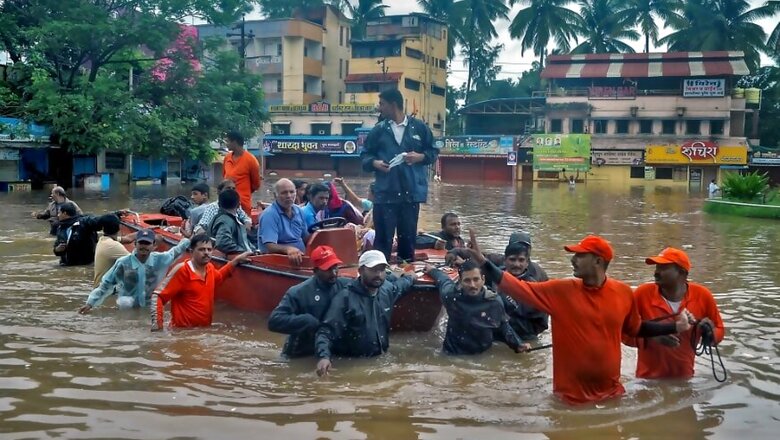
views
Pune: While the monsoon season is always welcomed for bringing respite from the summer heat and replenishing parched reservoirs, this year it wrecked havoc in parts of western Maharashtra where over 80 people lost their lives and lakhs got displaced after unprecedented rains.
Heavy showers pounded several districts in western Maharashtra, including Sangli, Kolhapur, Pune and Satara, causing flooding and damaging crops in August and September. Over 55 tehsils were badly hit in Kolhapur and Sangli.
As several villages got marooned, the National Disaster Response Force (NDRF) and Army had to be pressed into action to rescue people stranded there. Nearly 62 people were killed in floods and rain-related incidents in Pune division, which comprises Pune, Solapur, Satara, Sangli and Kolhapur districts, according to official figures.
Of these, 17 people lost their lives after a boat capsized near Brahmnal village in Sangli on August 8. "Seven to eight lakh people were shifted to safer places in Sangli and Kolhapur in August for which 105 rescue teams, 200 boats and two helicopters were used," an official at the Pune divisional commissioner's office said.
The then chief minister Devendra Fadnavis had to halt his pre-election tour of the state and visit the flood-affected districts to take stock of the situation. The floods damaged crops on over 4.89 lakh hectare agricultural land in the division and affected 8.73 lakh farmers, the official said.
The state government had to ask Karnataka to discharge water from the Almatti dam built on the Krishna river for the flood situation to ease in Maharashtra.
Pune, the state's second largest city and an educational hub, also witnessed mayhem in August and September as heavy rains lashed the district. Flash floods claimed over 20 lives in various parts of Pune in September.
According to an official, illegal constructions on water streams were the main cause of deluge in the city. Pune-based environmentalist Sarang Yadwadkar in August pinned the blame for rain fury on the state government, alleging that floodline of the Panchganga river in Kolhapur was "redefined" to provide benefits to the construction sector.
Maharashtra BJP chief Chandrakant Patil, however, later denied that the floodline of Kolhapur was altered by the then party-led state government due to pressure from the builders' lobby. The floodline defines the area which is no-go for development.
Talking to PTI on Thursday, Yadwadkar said, "There is a need to go into the root cause of all such incidents. Flooding, fire incidents, traffic jams, pollution are all symptoms. If we continue to treat the symptoms, we will never go to the root cause. The need is to tackle the root cause of all these problems."
He also said that urban planners need to identify the population-carrying capacity of cities and learn to differentiate between growth and "malignant growth". "Development of cities is unplanned because of uncontrolled migration. Migration takes place for job opportunities because people do not have infrastructure back in their villages. There is need for the migration to slow down," the activist opined.

















Comments
0 comment